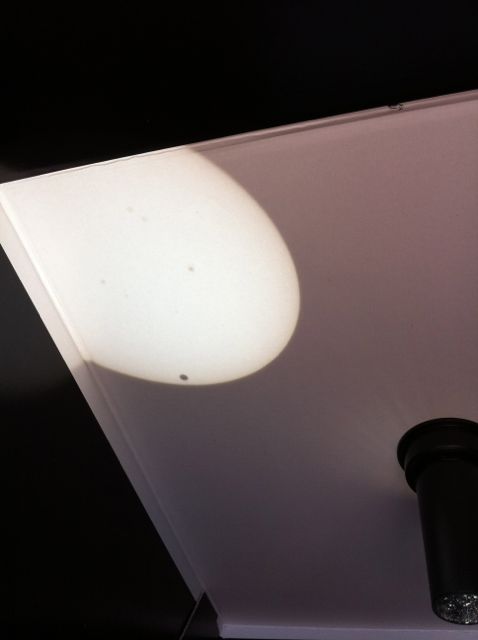
As I write this, Venus is in front of the sun; it looks like a tiny black dot near the northern edge of the sun. This event will last about 6 hours and 40 minutes from beginning to end. (It began at about 3 p.m. PDT and will end at about 9:40 p.m. PDT but the sun will set with the transit in progress at my location.) While visually the event is not particularly spectacular (although it is visually striking when viewed through a telescope with a suitable solar filter), it is rare and significant. Rare---Venus transits occur in pairs 8 years apart, every 105 years. There was a transit in 2004, which I saw, and the one in progress today; but the next pair will be in 2117 and 2125. Significant---Venus transits were used in the 17--19th centuries to obtain values for various distances in the solar system, particularly the distances between Earth, Venus and the sun.
To view the transit, I went to the local science museum (Oregon Museum of Science and Industry), where local amateur astronomers had telescopes set up for the public. (This event, still in progress as I write, is free to the public.) At the museum, I paid $2 for a pair of eclipse glasses (cardboard glasses with some kind of aluminized mylar through which it is safe to view the sun). The sun is a blueish white as viewed through the glasses, but Venus proved too tiny for my middle-aged eyes to see. But I got a variety of excellent views through the telescopes. One little scope provided a particularly wonderful view: a Coronado brand solar scope equipped with a "hydrogen alpha" filter that makes the sun look a vivid red, but which also shows solar prominences along the edge of the sun (these look like little tufts of flame). Venus was a jet-black round hole in the sun; there were several small sunspots which were not so dark.
One pleasant surprise was the quality of the view as shown by a simple cardboard device that was set up: This had some kind of little (and presumably inexpensive) telescope that projected the sun off a mirror and onto a white screen inside the cardboard box. I took a picture, a little while after the beginning of the transit. Notice the sunspots in the middle of the sun (rather faint little gray spots).

When I got home from the museum, I tried another way of viewing the transit: project an image using a pair of binoculars. It takes a little doing to point the binocs at the sun (while facing away from the sun!), but it worked like a charm. I held a white note pad about a foot behind the eyepiece, and was able to focus the bi